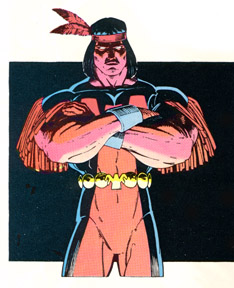X-Men Films Are Multiethnic, But Exclude IndiansBy Eric OlsonLast month, the fourth sequel in the profitable 20th Century Fox and Marvel Studios X-Men movie franchise was released to the home video market, selling over half a million units in the Blu-Ray format alone. X-Men: First Class continues in the spirit of the preceding films and its comic book origins by addressing social issues, most prominently civil rights, through the veil of a super powered conflict between the ideologies of peaceful versus violent methods of social change. Critics and audiences alike gave the film positive marks, lauding the filmmakers for threading the film’s themes through a multiethnic cast that reflected the central metaphor. Despite such an effort by the filmmakers and producers behind the franchise, among the myriad characters introduced in the five X-Men blockbusters, not one has been an American Indian.And:
While projects in other media have foregone American Indian characters, writers working with X-Men have at least tried by creating the characters of Mirage and Warpath in the 1980s. With the New Mutants title, Marvel wanted to explore further than ever before how each team member’s ethnic makeup contributed to the group and its success. This would seem to be an opportunity to introduce young readers to subtle traits that make cultures unique and valuable not just to the story at hand, but to society as a whole. It would be an opportunity to surprise the reader with cultural revelations that he or she may not have even encountered in a U.S. history classroom.
Instead, the writers largely succumb to the Hollywood expectations. Mirage is respectful of the ways of both modern America and her Cheyenne ancestry, but traditional Cheyenne chants are employed as little more than magic spells, their cultural significance degraded to a plot device. Warpath is a vengeful, powerful Apache warrior with a misplaced vendetta against the X-Men, a warrior whom, of course, also possesses the acute senses of a tracker. The two characters, as they were established, represent the polar notions of “Indianness” that have kept the American Indian a staple in storytelling for so long; nobility and savagery.
As the years passed, they both flowed toward the center, but at that point cultural ties are all but a backdrop for the drama of shifting personality and allegiances. The opportunity to forego stereotypes and develop powerful, meaningful representations of these perpetually misrepresented cultures had been missed.Comment: The X-Men have more Native characters than just Dani Moonstar (Mirage) and Warpath. There's Thunderbird, the original Native X-Man, who died soon after being introduced but still appears in alternate realities. Forge, who was a mainstay of the X-Men and X-Factor for years. And Shaman of Alpha Flight, who was introduced in the X-Men comics but isn't a member.
Thunderbird fits the "savage" model, but I'm not sure Forge fits the "noble" model. He's abandoned his cultural and religious heritage for the world of technology, so he may be the most realistic character of the bunch.
But Olson's basic point is valid. These characters are all superficial representations of what it means to be Native.
For more on the subject, see
Predator Has Best Native Superhero? and
Thunderbird in Future X-Men Movie?


1 comment:
Well, Thunderbird died quickly. That has its own issues. Really, most Marvel Indians are more on the magical end of the sliding scale of magic versus realism. Same with the aborigines, judging by House of M.
Forge is probably the only non-magical Indian Marvel's ever written, and only then by immersing himself in modern (and beyond-modern) tech.
Post a Comment